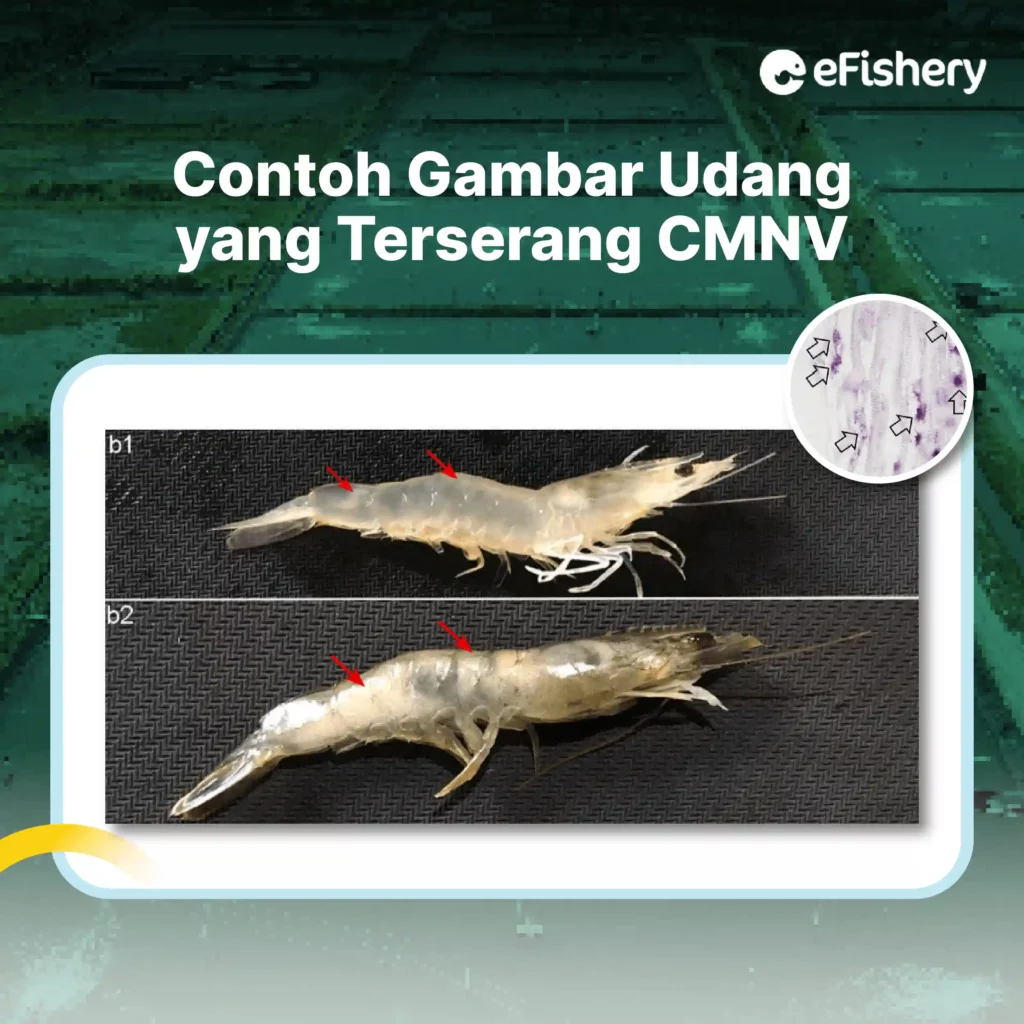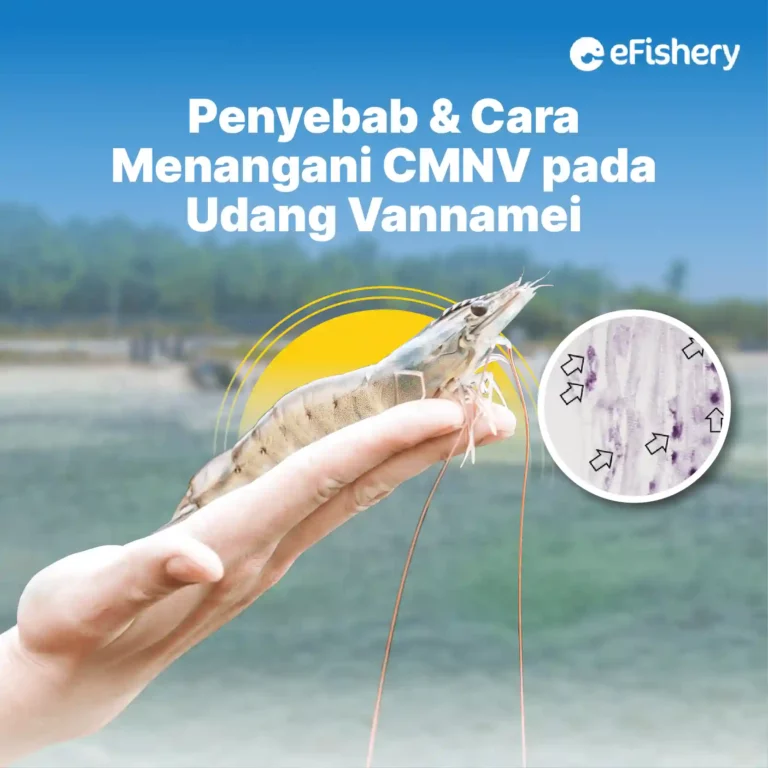Artikel Ini Telah Direview Oleh:

Nabilla Anggi
Magister Budidaya Perairan
CMNV in vannamei shrimp is a virus that farmers must watch out for. This is because CMNV attacks can cause shrimp VCMD or CMD disease. Read more here!
What is CMNV and VCMD Disease?
CMNV is Covert Mortality Nodavirus, a virus that causes shrimp VCMD disease. This virus was first observed in 2002 and first attacked in China (China). VCMD or Viral Covert Mortality Disease associated with Covert Mortality Disease (CMD). This disease infection is caused by CMNV stainvirus attack on seawater and brackish water shrimp. The targets of VCMD infection are the shrimp hepatopancreas, muscle, and lymphoid.
Timing and Causes of Shrimp Affected by VCMD
Shrimp can be infected with the CMNV virus and get VCMD disease from DOC 30. After being infected, there will be cumulative shrimp death up to DOC 60-80. However, in serious cases, VCMD can occur within 10-20 days after stocking the fry into the rearing pond.
The cause of CMNV infected shrimp is unstable environmental conditions, such as changes in temperature (especially above 28 degrees Celsius), sudden changes in salinity, NO levels2 (Nitrite) is high, the weather changes suddenly, and the stocking density of shrimp is too high.
In addition, in research conducted in China (China), frozen feed Artemia sp. and Acetes sp. suspected as a carrier of pathogens in cases of CMNV infection and represents a potential threat of new pathogen carriers for shrimp culture in feed. Therefore, it is advisable to avoid using frozen feeds whose pathogen-free status is unknown.
You must also be aware of 11 (eleven) species carrying the CMNV pathogen in vannamei shrimp, namely:
- Artemia sinica,
- Barnacle type Balanus sp.,
- Rotifer type Brachionus urceus,
- Amphipod type Corophium sinense Zhang,
- Pacific oyster or Pacific Crassostrea gigas,
- Types of hermit crabs Diogenes edwardsii,
- Mussels or Meretrix lusoria,
- ghost crab (Ocypode cordimundus),
- Amphipod hyperiid type Parathemisto gaudichaudi,
- Uca or Mangrove Crab Tubuca arcuate, And
- Amphipod gammarid.
In addition, migratory birds, aquatic insects, and humans can also be carriers (carrier) disease. CMNV can also be transmitted from shrimp to fish.
The spread of CMNV infection and VCMD disease can be through several ways, namely:
- vertical transmission, such as carrier invertebrates (carrier) disease
- horizontal transmission, such as offspring from a male or female parent, and
- shrimp cannibalism.
Besides being able to infect invertebrates, CMNV is also capable of cross-contamination from invertebrates to vertebrates such as fish, frogs and reptiles.
Symptoms of Shrimp Affected by VCMD Disease

Figure b1 above shows atrophy of the hepatopancreas or reduced number of cells in the tissue, pale or faded color, empty stomach and intestines, soft shell, mild muscle bleaching, and necrosis of the abdominal muscles. Figure b2. showed acute CMNV virus attack which was characterized by considerable muscle bleaching and necrosis in the shrimp stomach.
Shrimp infected with VCMD disease have weak movements so they usually sink to the bottom of the pond and their growth slows down. VCMD disease infection has a hidden pattern. Usually when siphoning is done at the bottom of the pond, a large number of shrimp die suddenly.
How to Diagnose VCMD Disease
VCMD disease can be diagnosed by looking at the symptoms and observing changes in the shrimp's body such as muscles turning white in color, empty stomach and intestines, pale color, and soft shrimp shells. To confirm the diagnosis of shrimp infected with CMNV virus and VCMD disease, you can do the RT-PCR, RT-LAMP, ISH (in situ hybridization), sequencing, and histopathology in the laboratory.
Impact and Method of Handling VCMD on Vannamei Shrimp
VCMD disease in vannamei shrimp can cause big losses to your business if not prevented. The impact of VCMD disease infection in shrimp is slow growth of shrimp and can cause death of up to 80% shrimp if not treated immediately.
If clinical signs of VCMD disease are seen, you can destroy the infected shrimp. However, if the CMNV virus has infected shrimp in all ponds, you must harvest early so that the disease does not spread to other ponds.
The way to prevent VCMD disease is to keep pond conditions sterile and tight biosecurity to prevent pests from entering the pond. In addition, you must maintain the quality of the water so that it stays in the optimal range, so that the shrimp are not easily stressed and attacked by disease.
Discussion of Shrimp Disease with Cultivation Experts
Need Help Regarding Shrimp Cultivation Business?
Fill in your personal data in the following form. Our team will immediately contact you via the number cellphone attached. Make sure the data entered is correct.
Currently, prevention efforts are one of the steps that can be taken to stop the transmission of VCMD disease. Apart from that, you can also hold discussions regarding problems with the CMNV virus and VCMD disease that occur in features Cultivation Consultation in application eFarm.
Cultivation Consultation eFarm is a feature that aims to help you get solutions to shrimp farming problems. You can ask questions directly to the cultivation experts and discuss how to get the right treatment steps. You can access this feature anytime and from anywhere for free. So what are you waiting for? Have eFarm right now!

Nabilla Anggi - Magister Budidaya Perairan
Nabilla merupakan lulusan sarjana dan magister budidaya perairan serta memiliki pengalaman di dunia perikanan baik hatchery maupun pembesaran
Questions Regarding CMNV on Vannamei Shrimp
CMNV is Covert Mortality Nodavirus, a virus that causes shrimp VCMD disease. This disease infection is caused by CMNV stainvirus attack on seawater and brackish water shrimp. The targets of VCMD infection are the shrimp hepatopancreas, muscle, and lymphoid.
The cause of CMNV infected shrimp is unstable environmental conditions, such as changes in temperature (especially above 28 degrees Celsius), sudden changes in salinity, NO levels2 (Nitrite) is high, the weather changes suddenly, and the stocking density of shrimp is too high.
- Liu., S., X. Wang, T. Xu, X. Li, L. Du and Q. Zhang. 2018. Vectors and reservoir hosts of covert mortality nodavirus (CMNV) in shrimp ponds. Journal of Invertebrate Pathology. 154: 29-36
- NACA. 2020. Viral covert mortality disease (VCMD): Disease card. Department of Agriculture and Water Resources Australia. 6 a.m.
- Yao, L., C. Wang, W. Wang, Y. Li, S. Liu, J. Kong and Q. Zhang. 2022 Cases report of covert mortality Nodavirus infection in indoor farming Penaeus vannamei. Aquaculture Reports. 25:1-8
